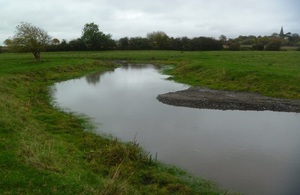East Kent chalk stream thrives again after restoration project
Environment Agency funding sees eels, bullheads and brook lamprey back in England's rainforest.

The Little Stour is now narrower, deeper and winding to benefit wildlife
A Kentish river is now reaping the environmental benefits of a partnership makeover project that has restored more than 300 metres of rare chalk stream habitat at Seaton, near Canterbury.
Kentish Stour Countryside Partnership delivered work that transformed part of the much-loved Little Stour between Wickhambreaux Village and Seaton Mill.
This partnership project, with assistance from the 3 landowners, was originally completed in 2016, but a recent drone survey of the river showed how the scheme is benefitting the Little Stour following the improvement works.
Tom Reid, a technical specialist for the Environment Agency, said:
We are delighted to work together with our partners at the Kentish Stour Countryside Partnership on such an important project.
Chalk streams are precious habitats, havens for wildlife and highly-valued by local communities and visitors alike. Their future depends on collective action, and this project is therefore a much-needed and welcome step towards addressing the many pressures these rare watercourses face.
Martin Thomas, of the Kentish Stour Countryside Partnership, said:
I’m struck by how this stretch of river has been transformed by our project.
When I first visited in 2016 to speak to the owners to gain their approval, it was barren – straight, shallow, with little or no vegetation. It’s now teeming with wildlife. We’re very grateful to the owners of the river and adjoining land for their enthusiastic support.
The collaborative £28,000 project, funded by the Environment Agency, local landowners and volunteers, involved narrowing the overly-widened river to restore this valuable stretch of chalk stream by changing the profile of the river bed and banks.

Funding from the Environment Agency allowed the Little Stour to come back to life
Using a mechanical excavator, a series of pools were dug into the riverbed, and gravel was removed onto the edges of the river. This created a narrower, deeper, winding channel during summer when the water level is low. Deeper water in the pools is expected to be cooler in the warmer temperatures expected with climate change over the coming decades.
As a result of the enhancement work, fish passage has now become much easier and a more varied habitat has developed for all aquatic and riverside wildlife to thrive. The riverbanks were then fenced and trees were planted along the river and in the adjacent fields.
Since the project was completed, fish recorded in the restored stretch include eels, bullheads and brook lamprey - all of which are rare and priority species. There have also been reports of kingfishers and otters just upstream of the site.
The project has also provided flood-protection benefits as well as the river banks being raised with clay to further reduce flood risk to residents in Seaton.
Other work included in the project included a crossing point allowing cattle to reach the adjacent fields for grazing. A cattle drink was also created at one short section of river, with gates preventing cows from accessing the rest of the watercourse. This stops cattle grazing on the river vegetation, allowing wild plants to grow in the water and on the banks, providing better habitat for wildlife.
Chalk streams are a rare and valuable habitat, often referred to as the equivalent of England’s rainforests or Great Barrier Reef. Some 85% of all chalk streams are found in England, mainly in the south and east of the country, as well as dozens of smaller chalk springs and watercourses.
However, they face unique challenges in the 21st century because of complex problems exacerbated by climate change and population growth. They flow through some of the most urbanised, industrialised, and intensively-farmed parts of the country. Over-abstraction, pollution, and habitat degradation are serious concerns for environmental groups and other stakeholders.
To find out more about the project, please visit https://kentishstour.org.uk/seaton-river-restoration/ and aerial drone footage of the scheme is available to view here: https://www.youtube.com/watch?v=WZVSxDlQrds
-
Kentish Stour Countryside Partnership works closely with landowners and local communities to promote both landscape and nature conservation, and develop opportunities for appropriate access and informal recreation. It operates as a working partnership of sponsoring organisations, staff and local people.
-
A recent chalk stream strategy, published by Catchment Based Approach’s (CaBA) Chalk Stream Restoration Group (CSRG), sets the future direction needed to protect and enhance England’s chalk streams.
-
The strategy at https://catchmentbasedapproach.org/learn/chalk-stream-strategy/ is for everyone who has responsibility for, or uses, chalk streams. It sets out actions and recommendations for government, regulators and the water industry on water resources, water quality and habitat restoration and management.
-
The Catchment Based Approach (CaBA) is an inclusive, civil society-led initiative that works in partnership with Government, Local Authorities, Water Companies, businesses and more, to maximise the natural value of our environment.
-
Chalk streams face numerous pressures:
- low flows due to unsustainable abstraction
- poor water quality due to point source discharges and diffuse pollution
- poor habitats due to man-made impacts such as straightening channels and barriers to fish migration.
- Historically, industry practice, dredging and structures which cause habitat loss, have all contributed to their degradation.